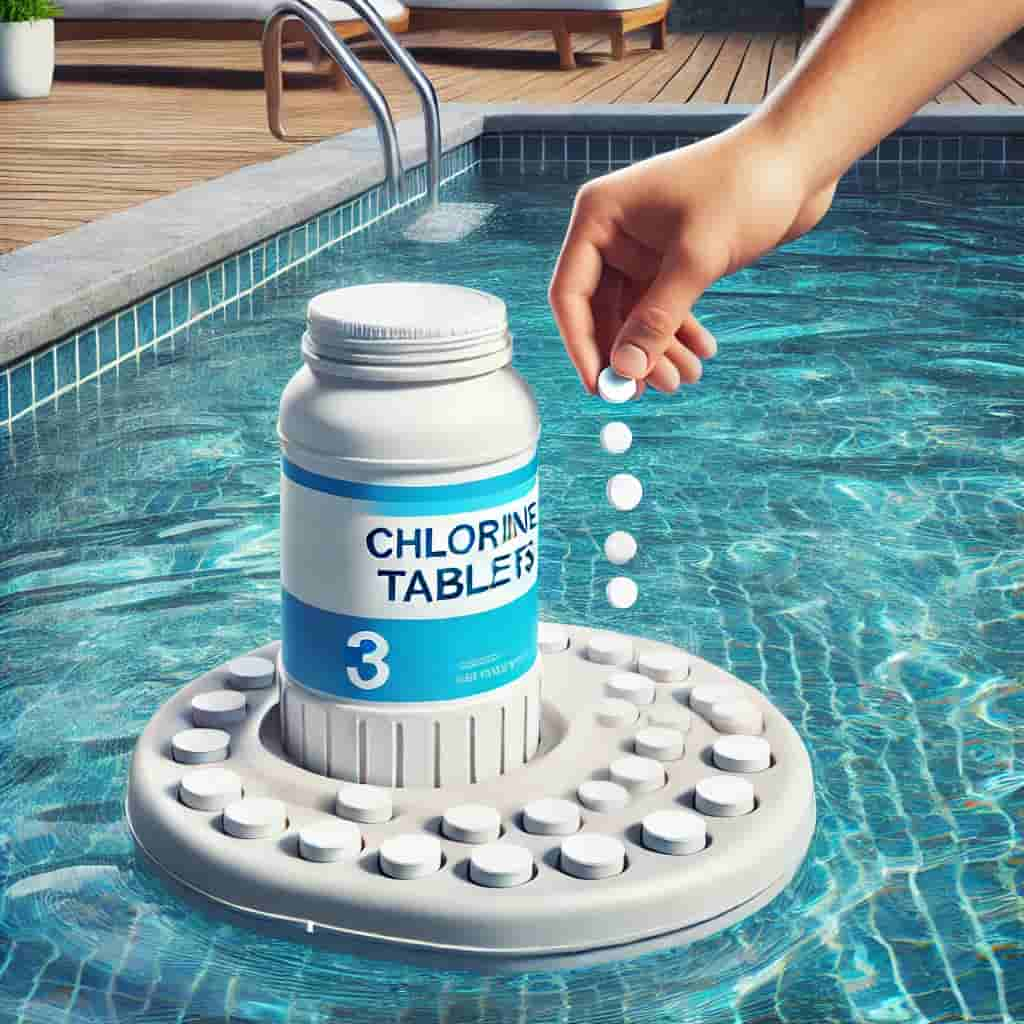Maintaining the perfect balance of chemicals in your swimming pool is crucial for keeping the water clean, clear, and safe for swimmers. Among the essential chemicals used for pool maintenance, chlorine tablets play a vital role. These tablets are designed to slowly dissolve in the water, releasing chlorine to sanitize and disinfect the pool. However, knowing how many chlorine tablets to add to your pool can be challenging, especially for new pool owners. In this blog post, we’ll discuss the factors that influence the number of chlorine tablets you need and provide a comprehensive guide to help you maintain optimal pool chlorine levels.

Understanding the Role of Chlorine Tablets
Chlorine tablets are a convenient and effective way to introduce chlorine into your pool. They are typically made from trichloro-s-triazinetrione, a compound that releases chlorine gradually as it dissolves. This slow-release mechanism ensures a consistent level of chlorine in the water, which is essential for killing bacteria, algae, and other harmful microorganisms.
Factors Influencing the Number of Chlorine Tablets
Several factors determine the number of chlorine tablets you should add to your pool. These include the size of your pool, the current chlorine level, the pool usage frequency, and environmental factors such as temperature and sunlight exposure.
1. Pool Size:
The size of your pool is the most critical factor in determining the number of chlorine tablets needed. Pools are typically measured in gallons, and knowing your pool’s volume is essential for accurate dosing.
2. Current Chlorine Level:
Before adding more chlorine tablets, test your pool water to determine the current chlorine level. This helps avoid over-chlorination, which can cause skin and eye irritation.
3. Pool Usage:
The more frequently your pool is used, the higher the chlorine demand. Heavy usage introduces more contaminants, requiring more chlorine to maintain sanitary conditions.
4. Environmental Factors:
Sunlight and temperature significantly impact chlorine levels. UV rays from the sun break down chlorine, reducing its effectiveness. Warmer temperatures can also increase chlorine consumption as microorganisms thrive in warm water.
Calculating the Number of Chlorine Tablets
To calculate the number of chlorine tablets needed for your pool, follow these steps:
1. Determine Your Pool’s Volume:
Measure the dimensions of your pool (length, width, and average depth) and use the following formula to calculate the volume in gallons:
Volume (in gallons) = Length (ft) x Width (ft) x Average Depth (ft) x 7.5
2. Test the Current Chlorine Level:
Use a pool testing kit to measure the free chlorine level in your pool. The ideal range is between 1-3 ppm (parts per million).
3. Calculate the Required Chlorine:
If your chlorine level is below the recommended range, you’ll need to add more chlorine tablets. Typically, one 3-inch chlorine tablet treats 5,000 gallons of water.
For example, if your pool has a volume of 20,000 gallons, you would need four 3-inch chlorine tablets to maintain proper pool chlorine levels:
Number of tablets = Pool volume (in gallons) / 5,000= 20,000 / 5,000= 4 tablets
Maintaining Optimal Pool Chlorine Levels
Maintaining the right balance of pool chlorine is an ongoing process. Here are some tips to help you keep your pool water clean and safe:
1. Regular Testing:
Test your pool water at least twice a week, especially during peak swimming season. Regular testing helps you stay on top of chlorine levels and make adjustments as needed.
2. Consistent Tablet Addition:
Add chlorine tablets to your pool consistently to ensure a steady chlorine supply. Use a floating dispenser or an in-line chlorinator for even distribution.
3. Monitor Stabilizer Levels:
Chlorine stabilizers, such as cyanuric acid, help protect chlorine from UV degradation. However, too much stabilizer can reduce chlorine effectiveness. Keep stabilizer levels between 30-50 ppm.
4. Shock Treatment:
Occasionally, perform a shock treatment to raise chlorine levels quickly and eliminate any resistant bacteria or algae. Follow the manufacturer’s instructions for shock dosing.
5. Maintain Proper pH Levels:
The effectiveness of chlorine is influenced by the pool’s pH level. Maintain a pH range of 7.2-7.6 for optimal chlorine performance.
Troubleshooting Common Chlorine Issues
Even with careful maintenance, you may encounter some common chlorine issues. Here are solutions to a few problems you might face:
1. Low Chlorine Levels:
If chlorine levels are consistently low, check for high stabilizer levels, excessive sunlight exposure, or organic matter like leaves and debris. Adjust stabilizer levels, use a pool cover, and clean the pool regularly.
2. High Chlorine Levels:
Over-chlorination can be harmful. If levels are too high, dilute the pool water by partially draining and refilling the pool. Avoid swimming until levels return to the safe range.
3. Chlorine Odor and Irritation:
A strong chlorine smell or irritation can indicate chloramines, which are formed when chlorine combines with contaminants. Shock the pool to break down chloramines and improve water quality.
4. Algae Growth:
Algae can consume chlorine rapidly, leading to low levels. Brush and vacuum the pool, then shock it to eliminate algae. Use algaecide if necessary.
Conclusion
Maintaining the right number of chlorine tablets in your pool is essential for ensuring clean and safe swimming conditions. By considering factors like pool size, current chlorine levels, usage, and environmental conditions, you can accurately determine the number of tablets needed. Regular testing and consistent maintenance will help you keep your pool chlorine levels within the ideal range, providing a pleasant and healthy swimming experience for everyone. Remember, a well-maintained pool is a happy pool!



